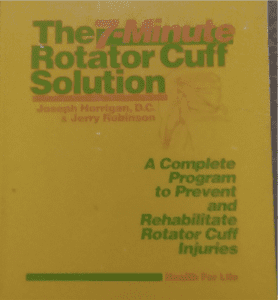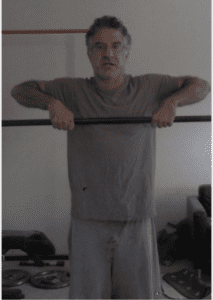The upright row is an exercise that has gone in and out of fashion. Used for decades, they became unpopular in the 90’s and beyond due to safety concerns. But much of that issue had to do with how the upright row was done. So today let me answer a question that I see/get a lot which is: are upright rows safe?
My hair isn’t actually as crazy as it looks. The thing on the top of my head is part of my rack.
Table of Contents
A Comment on Exercise Selection
In recent years, what have been come to be called the “exercise police” can be found online. While some are just folks making technical nitpicks, many are the ones proclaiming that a given exercise “is” or “is not” dangerous. The problem here is that it’s simplistic to look at any given exercise in this fashion.
Rather, it’s better to look at exercises in terms of their pros and cons or perhaps in a risk:reward sort of way. That is, are the potential risks of an exercise worth the potential rewards. As well, you can only ever look at at any given exercise within a given context. At best any exercise might be considered safe or unsafe for a given trainee in a given situation. There are few absolutes.
That said, the upright row specifically is often surrounded by its share of “This is an unsafe exercise” beliefs. Let’s look at why.
The 7-Minute Rotator Cuff Solution
I think the first place I saw it asserted that upright rows were categorically unsafe was in the old 7-Minute Rotator Cuff Solution from Health for Life (HFL).
HFL is a now defunct company that put out a variety of different manuals many of which were quite good and/or ahead of their time. Of course, I have most of them on my bookshelf.
They based their argument on the fact that the upright row put the shoulder in an internally rotate and horizontally ABducted position. Which I won’t try to really explain but has the effect of putting the shoulder at risk for impingement. Hence to avoid shoulder problems, upright rows became one of the big no-no exercises for people. But it’s not as if the idea doesn’t still persist.
As an amusing note: many of the people I saw raging against upright rows BECAUSE THEY WERE DANGEROUS were always in the camp of teaching everyone deadlifts and power cleans. You know, movements with zero known safety risk. My point that, given the choice I’d rather have shoulder issues than low back problems went nowhere. But I digress.
Are Upright Rows Unsafe?
But is the above strictly true. Well, certainly as they are commonly done or recommended in the bodybuilding subculture, I would consider the upright row an unsafe exercise. Typically bodybuilders will use a straight bar, narrow grip and pull the bar as high as possible. Often this means pulling to below the chin with the elbows nearly at ear level.
As you can see, the elbows are being brought very high (often the goal is to get them to the ears) and certainly that tends to put the rotator cuff in a high risk position even with excellent shoulder control. As well, you don’t really get a whole lot more involvement of the deltoids in the first place by pulling the bar this high. So you increase the risk without really impacting on the movement’s benefit as a shoulder movement.
So for those reasons, I certainly wouldn’t recommend folks do upright rows using that technique. The risk is high and the benefit relatively low. This is especially true given that it’s easy to modify the movement into one that is not only safer for the shoulder but targets the deltoids just as effectively.
Modifying the Upright Row
The key to making the upright row safer is to limit the range of motion, only lifting until the elbows are even with the shoulders. Typically this will put the hands/weight at about sternum level. Here’s the barbell version of this.
By limiting the range of motion in this fashion, there is far less of a risk for impingement of the shoulder. But it still provides plenty of muscular tension for the side delt. I’d mention that it does still require some ability to control the scapula (in terms of setting the shoulder down and not letting it elevate) so someone with a previous rotator cuff injury might still have problems with it. But for someone with good scapular control and no other shoulder issues, I see no problem with doing upright rows in this fashion.
DB Modified Upright Row
One issue with the barbell version of the upright row, no matter how it’s done is that the wrists get kinked pretty hard at the top. This can be avoided or at least limited by doing the movement with dummbells. This gives the wrists far more movement and the stress tends to be a lot less.
My elbows should actually be a little bit higher in that picture. But it gets the point across. DB’s also allows the movement to be a bit more up and out and you can see that my wrists are in a far more neutral position.
Rope Modified Upright Row
A final variation of the modified upright row is to use a rope handle off of a low cable. Sadly, I gave my bands to someone to use during the Coronavirus pandemic so I’m demonstrating with a dual dog leash. I think you get the idea.
So are Upright Rows Unsafe?
Well, I’d say that it all depends on how you do them. Done in the traditional way, they certainly have a fairly high risk to reward ratio. In the modified version, limiting the movement to pulling no higher than elbows level with the shoulders, any risk is vastly reduced. Mind you, the movement does still require some scapular control and for people with previous shoulder injuries, the movement may still be a no-go.
But for people with health shoulders who do the movement as I’ve shown, I don’t see the upright row being inherently any more unsafe than a lot of other movements people regularly advocate and perform.
Similar Posts:
- Cable Row Technique
- Bench Press Variations
- Lat Pulldown Technique
- A Guide to Bench Press Technique
- Split Routine Sequencing





Funny, I was thinking about this issue myself, and just in time here`s the answer.
Somewhat wrecked my rotator cuffs trying to build some muscles, apparently I´m prone to shoulder injury and just did all the potentially harmful exercises.
Bad part of shoulder injury is the weeks or months it takes for it to heal, during which you are deprived of most exercises…
Hi Lyle
Good, sensible advice. What do you think of performing the movement you suggest with a curling bar to reduce the cock of the wrists?
Martin
not a form safety recommendation but thought I’d add something I see very few mention. I do upright rows on a cable row machine with an ez bar attatchment. you could also use any other single arm(s) attachment like shown in lyle’s post, but I just find the lying vs. standing really has my medial delts firing for some reason.
Never heard of anyone using upright rows for delts, always seen them as a trap exercise.
Thanks for the fast response, I think I will switch to shrugs instead, since even doing movement not all the way up makes my shoulders feel bit weird.
What do you think of adding this exercise to your generic bulking routine? The upper day would be something like:
Flat bench
Row
Incline Bench
Pulldown/Chins
Upright Row
Tricep
Bicep
but the guy in the first picture looks more jacked than the guy in the second picture….
Lyle,
Personally, I’ve never felt that upright rows had a potential for causing injury over other exercises. As long as you know what you’re doing, and are using proper for, then you should be ok. I prefer the dumbbell method when I’m working the shoulders. Bands are great for warming up, but they can be costly when you need to work with some serious resistance.
-Mitchell
I personally do them using DB and pull them in the direction exactly opposite of a dips.
I think that about says it all, great read and great advice. I used to love upright rows and now at an aolder age 40+ the shoulders are shot and crack and pop, all makes sense now. and I agree with Mitchell, dumbbells are the way to go, barbells are a killer for sure, no motion for any joint.
The real question is, are upright rows anything other than a complete waste of programming space for people who don’t have the recovery abilities of a heavy steroid user/Wolverine from X-Men?